fuel pump Citroen C4 PICASSO 2016 2.G Owner's Manual
[x] Cancel search | Manufacturer: CITROEN, Model Year: 2016, Model line: C4 PICASSO, Model: Citroen C4 PICASSO 2016 2.GPages: 527, PDF Size: 13.72 MB
Page 10 of 527
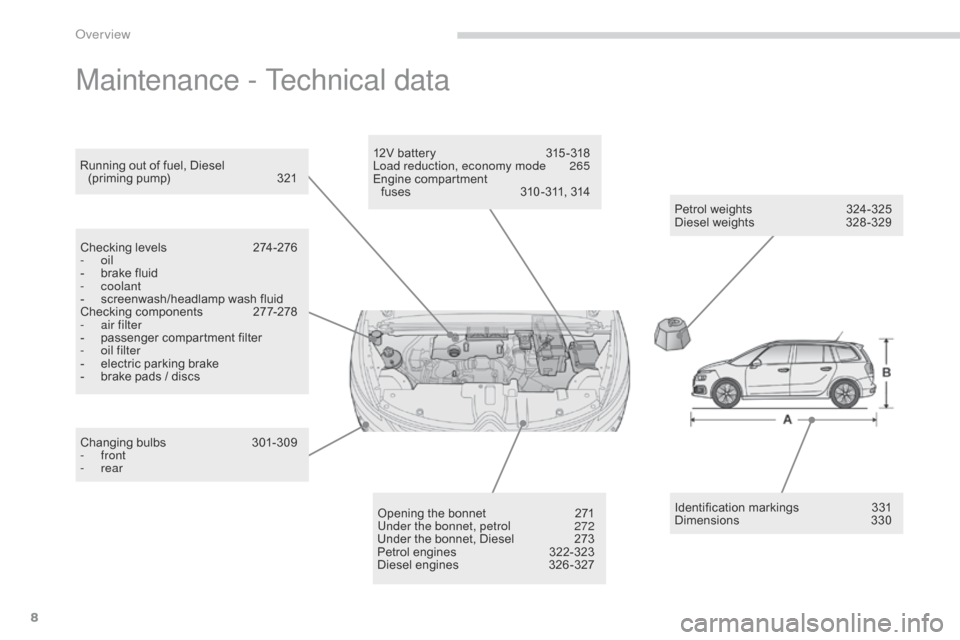
8
C4-Picasso-II_en_Chap00b_vue-ensemble_ed01-2016
Maintenance - Technical data
Petrol weights 324-325
Diesel weights 3 28 -329
Running
out
of
fuel,
Diesel
(priming
pump)
3
21
Checking
levels
2
74-276
-
oil
-
b
rake
fluid
-
coolant
-
s
creenwash/headlamp
wash
fluid
Checking
components
2
77-278
-
a
ir filter
-
p
assenger
c
ompartment
f
ilter
-
o
il filter
-
e
lectric
parking
brake
-
b
rake
pads
/
discs
Changing
bu
lbs
3
01-309
-
front
-
rear Opening
the
bonnet
2
71
Under the bonnet, petrol
2
72
Under
the
bonnet,
Diesel
2
73
Petrol
engines
3
22-323
Diesel
engines
3
26 -327 Identification
ma
rkings
3
31
Dimensions
3
30
12V
battery
3
15 -318
Load reduction, economy mode
26
5
Engine
c
ompartment
f
uses
31
0 - 311,
31
4
Over view
Page 259 of 527
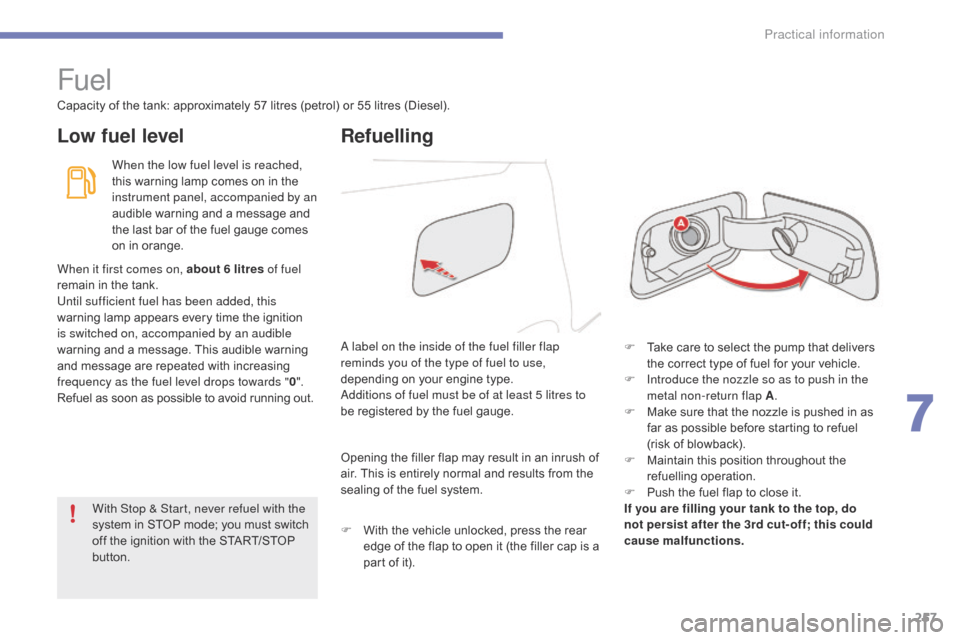
257
C4-Picasso-II_en_Chap07_info-pratiques_ed01-2016
Fuel
Capacity of the tank: approximately 57 litres (petrol) or 55 litres (Diesel).
Low fuel levelRefuelling
When the low fuel level is reached,
this
warning lamp comes on in the
in
strument panel, accompanied by an
audible
warning and a message and
t
he last bar of the fuel gauge comes
o
n in orange.
F
T
ake care to select the pump that delivers
t
he correct type of fuel for your vehicle.
F
I
ntroduce the nozzle so as to push in the
metal non-return flap A .
F
M
ake sure that the nozzle is pushed in as
f
ar as possible before starting to refuel
(risk
of blowback).
F
M
aintain this position throughout the
r
efuelling
ope
ration.
F
P
ush the fuel flap to close it.
If you are filling your tank to the top, do
not persist after the 3rd cut- off; this could
cause malfunctions.
A label on the inside of the fuel filler flap
reminds you of the type of fuel to use,
depending
on your engine type.
Additions of fuel must be of at least 5 litres to
be
registered by the fuel gauge.
When it first comes on, about 6 litres of fuel
remain
in
the tank.
Until sufficient fuel has been added, this
warning
lamp appears every time the ignition
i
s switched on, accompanied by an audible
warning
and a message. This audible warning
a
nd
message are repeated with increasing
f
requency as the fuel level drops towards " 0".
Refuel
as
soon as possible to avoid running out.Opening
the filler flap may result in an inrush of
a
ir. This is entirely normal and results from the
s
ealing of the fuel system.
F
W
ith the vehicle unlocked, press the rear
e
dge of the flap to open it (the filler cap is a
p
art of it).
With Stop & Start, never refuel with the
system
in STOP mode; you must switch
o
ff
the ignition with the START/STOP
b
utton.
7
Practical information
Page 260 of 527
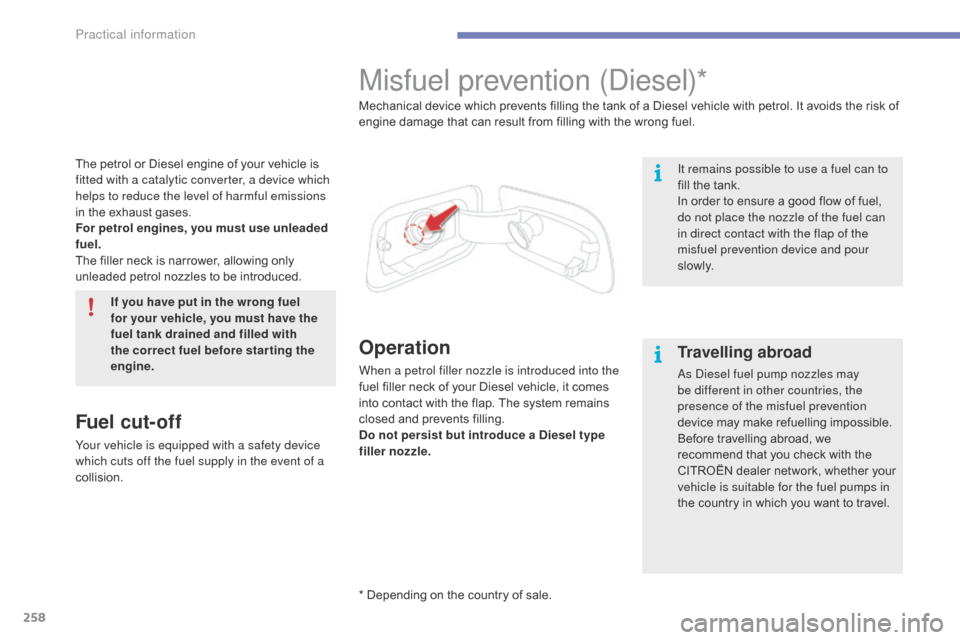
258
C4-Picasso-II_en_Chap07_info-pratiques_ed01-2016
The petrol or Diesel engine of your vehicle is fitted with a catalytic converter, a device which
helps to reduce the level of harmful emissions
in
the exhaust gases.
For petrol engines, you must use unleaded
fuel.
The
filler neck is narrower, allowing only
u
nleaded petrol nozzles to be introduced.
If you have put in the wrong fuel
for your vehicle, you must have the
fuel tank drained and filled with
the correct fuel before star ting the
engine.
Fuel cut- of f
Your vehicle is equipped with a safety device
which cuts off the fuel supply in the event of a
collision.
Misfuel prevention (Diesel)*
Operation
When a petrol filler nozzle is introduced into the
fuel filler neck of your Diesel vehicle, it comes
i
nto contact with the flap. The system remains
c
losed and prevents filling.
Do not persist but introduce a Diesel type
filler nozzle. Mechanical device which prevents filling the tank of a Diesel vehicle with petrol. It avoids the risk of
e
ngine damage that can result from filling with the wrong fuel.
It remains possible to use a fuel can to
fill the tank.
In order to ensure a good flow of fuel,
d
o not place the nozzle of the fuel can
in direct contact with the flap of the
misfuel prevention device and pour
s l ow l y.
Travelling abroad
As Diesel fuel pump nozzles may
be different in other countries, the
presence of the misfuel prevention
device
may make refuelling impossible.
Before
travelling abroad, we
r
ecommend that you check with the
C
ITROËN dealer network, whether your
v
ehicle is suitable for the fuel pumps in
the
country in which you want to travel.
* Depending
on
the
country
of
sale.
Practical information
Page 261 of 527
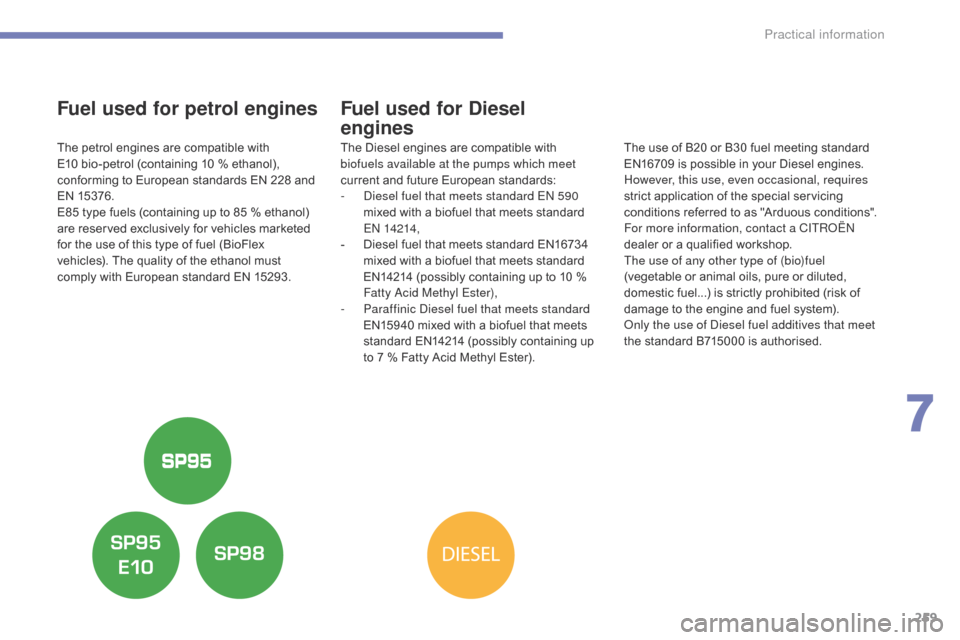
259
C4-Picasso-II_en_Chap07_info-pratiques_ed01-2016
Fuel used for petrol engines
The petrol engines are compatible with E10 bio-petrol (containing 10 % ethanol),
c
onforming to European standards EN 228 and
E
N
1
5376.
E85
type fuels (containing up to 85 % ethanol)
a
re reserved exclusively for vehicles marketed
f
or the use of this type of fuel (BioFlex
v
ehicles). The quality of the ethanol must
c
omply with European standard EN 15293.
Fuel used for Diesel
engines
The Diesel engines are compatible with biofuels available at the pumps which meet
current
and future European standards:
-
D
iesel fuel that meets standard EN 590
mixed
with a biofuel that meets standard
E
N 14214,
-
D
iesel fuel that meets standard EN16734
m
ixed with a biofuel that meets standard
E
N14214 (possibly containing up to 10 %
F
atty Acid Methyl Ester),
-
P
araffinic Diesel fuel that meets standard
EN15940
mixed with a biofuel that meets
s
tandard EN14214 (possibly containing up
t
o 7 % Fatty Acid Methyl Ester).The
use of B20 or B30 fuel meeting standard E
N16709 is possible in your Diesel engines.
H
owever, this use, even occasional, requires
strict
application of the special servicing
c
onditions referred to as "Arduous conditions".
F
or more information, contact a CITROËN
dealer
or a qualified workshop.
The use of any other type of (bio)fuel
(vegetable
or animal oils, pure or diluted,
d
omestic fuel...) is strictly prohibited (risk of
d
amage to the engine and fuel system).
Only the use of Diesel fuel additives that meet
the
standard B715000 is authorised.
7
Practical information
Page 323 of 527
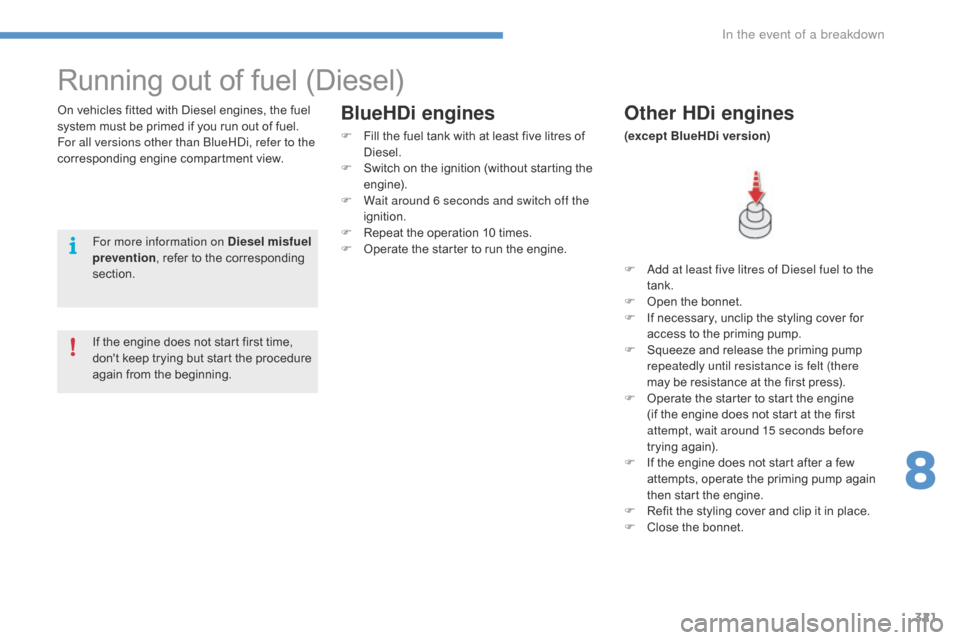
321
C4-Picasso-II_en_Chap08_en-cas-panne_ed01-2016
Running out of fuel (Diesel)
On vehicles fitted with Diesel engines, the fuel system must be primed if you run out of fuel.
For all versions other than BlueHDi, refer to the
corresponding
engine compartment view.Other HDi engines
(except BlueHDi version)
For more information on Diesel misfuel
prevention ,
refer
to
the
corresponding
s
ection.
If
the
engine
does
not
start
first
time,
d
on't
keep
trying
but
start
the
procedure
a
gain
from
the
beginning.
BlueHDi engines
F Fill the fuel tank with at least five litres of D
iesel.
F
S
witch on the ignition (without starting the
e
ngine).
F
W
ait around 6 seconds and switch off the
ignition.
F
R
epeat the operation 10 times.
F
O
perate the starter to run the engine.F
A
dd at least five litres of Diesel fuel to the
tank.
F
O
pen the bonnet.
F
I
f necessary, unclip the styling cover for
a
ccess to the priming pump.
F
S
queeze and release the priming pump
r
epeatedly until resistance is felt (there
may
be resistance at the first press).
F
O
perate the starter to start the engine
(
if the engine does not start at the first
a
ttempt, wait around 15 seconds before
trying
ag
ain).
F
I
f the engine does not start after a few
a
ttempts, operate the priming pump again
t
hen start the engine.
F
R
efit the styling cover and clip it in place.
F
C
lose the bonnet.
8
In the event of a breakdown